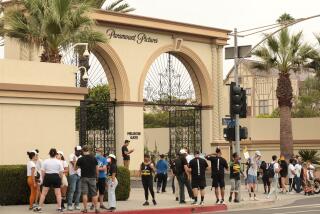FCC Eyes an Index for Media Mergers
WASHINGTON — Deep inside the halls of the Federal Communications Commission, a search is on for The Formula.
It is not a recipe for next-generation fiber optics or a way to stretch the broadcast spectrum. Rather, the elusive calculation, being pursued by a handful of FCC economists, is a simple mathematical solution to one of the agency’s most perplexing philosophical debates:
When it comes to media mergers, how big is too big?
As part of an ongoing review of the FCC’s media-ownership rules, Chairman Michael K. Powell is offering a reward to the first FCC economist who can bring him an objective scientific formula that will accurately measure the diversity of media voices in a local market. A former antitrust attorney, Powell says he wants something akin to the widely accepted index used by the Justice Department when reviewing whether mergers create a monopoly.
Now, the race is on.
If Powell prevails -- and it’s by no means clear that he will -- he could move toward transforming a rancorous legal and social debate that has preoccupied generations of FCC commissions into a simple, neat algebraic equation that is blind to political interpretations and consistently applied. Simply drop in a few numbers based upon the specifics of a local market and let the index tell you whether diversity is strong or weak.
The very idea is quintessential Powell, who has never been comfortable with vague concepts or loose definitions. He once famously called the FCC’s public-interest standard an “empty vessel” into which politicians can pour their preconceived notions. As a commissioner, he tried -- without success -- to convince colleagues to embrace a set of guidelines to narrowly define the weighty but subjective standard.
Now the chairman is seeking to bring a similar order and predictability to the concept of diversity, an issue that lies at the heart of the media-ownership debate.
“The chairman has challenged everyone in this process to base the rationale for the rules on empirical evidence and data versus intuition, personal opinion and taste,” said Susan Eid, Powell’s legal advisor for media issues. “If we could create a diversity index, it would be something that would survive time so that every other commission doesn’t have to go through the same intensive fact-gathering process that we are.”
Eid and other FCC officials declined to comment on the specifics of a possible formula or just what the reward might be for the clever economist who creates it.
But Powell hinted recently that the agency has “some interesting work going on” to develop a diversity index, based upon data collected from 12 FCC-commissioned studies.
Many are nevertheless skeptical, questioning whether a calculator will ever be the proper tool to determine how big media companies can grow, who can control what Americans see on television or how the public is informed.
“This isn’t something that can be figured out to the tenth of a decimal point,” said actor Richard Masur, a former Screen Actors Guild president.
“Explain to me how we can quantify something as subjective as diversity or quality.... An index is a fine idea, if you could do it, but one of the reasons we have a commission is so that the members exercise their judgment.”
Powell has said the quest for a diversity index was born out of a string of FCC defeats in federal court, which remanded many of the agency’s media-ownership rules and ordered the FCC to stop relying on hunch and opinion and come up with some evidence to justify its regulations.
Powell is betting that a scientific formula -- designed to factor in the varying size of local markets, the number and type of media outlets available, and common ownership of different outlets by the same company -- will have the same appeal to the courts that it has to him.
Courts have long held that fostering a diversity of viewpoints and local voices in the media is crucial to the health of the nation’s democracy. These judicial decrees form the basis upon which the FCC is empowered to enforce its ownership rules. The rules generally prevent the same company from dominating a local market by owning too many TV stations or controlling both a newspaper and a TV station. (Tribune Co., owner of the Los Angeles Times and KTLA-Channel 5, is fighting to overturn the rules.)
The concept of a cold calculation is based upon the Herfindahl-Hirschman index, or HHI, a long-accepted measure of market concentration that the Justice Department uses to evaluate the potential harm of proposed mergers. The index is based on work performed more than 50 years ago by Orris Herfindahl, a respected environmental economist who died while trekking through Nepal in 1972, and Albert O. Hirschman, a member of the Institute for Advanced Study at Princeton University.
The Justice Department formula is relatively straightforward. Take the square of the market share of each company in an industry and add the results together. By and large, if the sum is greater than 1,800, the market is considered to be dangerously concentrated.
The HHI has worked nicely and without much controversy for decades. Because virtually anyone can quickly calculate the market effect of a proposed merger, the index has taken some of the mystery out of antitrust philosophy and ensured more consistent enforcement from administration to administration.
But to develop a similar index to measure media diversity -- a far more abstract concept -- will be trickier, economists say. The HHI is meant to assess the effect of concentration on consumer prices, whether it’s toothpaste or telephone service. A diversity index would need to gauge such intangible things as freedom of speech, civic discourse, news slant or the quality of TV shows.
“The issues here are complex and subjective,” said Dean Baker, an economist at the Washington-based Center for Economic Policy and Research who has criticized the FCC’s recent research into media ownership. “They don’t lend themselves to an index.”
What sort of diversity would be measured, he wonders. Diversity of programming? Of ownership? Of viewpoints expressed?
And whose voice counts? “They’re looking for a diversity of voices, but it’s not clear what a voice is,” said Joel Waldfogel, a business professor at the University of Pennsylvania’s Wharton School who was commissioned by the FCC to conduct one of its recent studies.
Many agree that a local newspaper and local TV station would each probably count as a distinct “voice” in a market. But what about the Internet? Or magazines? Does the local cable operator count as one voice or should the FCC count each channel offered on the cable system as a separate voice?
“In Milwaukee, should the local NBC news affiliate count equally to the Web site for the Milwaukee Astronomical Society?” asked Mark Cooper, research director for the Consumer Federation of America. “Yes, they are both voices, but one is much louder.”
Economists say the FCC will need to grapple with these issues and many more. They predict that any formula would need to account for different types and reaches of various media outlets, perhaps giving greater weight to a daily newspaper than to, say, a small radio station.
Where the lines are drawn is certain to generate controversy. Some critics already worry that the FCC will use a complex formula to obscure the issues and push through deregulation.
As in most big FCC decisions, court appeals are highly probable.
Cooper supports the idea of using a diversity index, though he says the critical issue will be what factors are included in the formula. “This isn’t just commodity analysis,” he said. “It’s not shoes or soap we’re talking about. This is about democratic discourse.”


